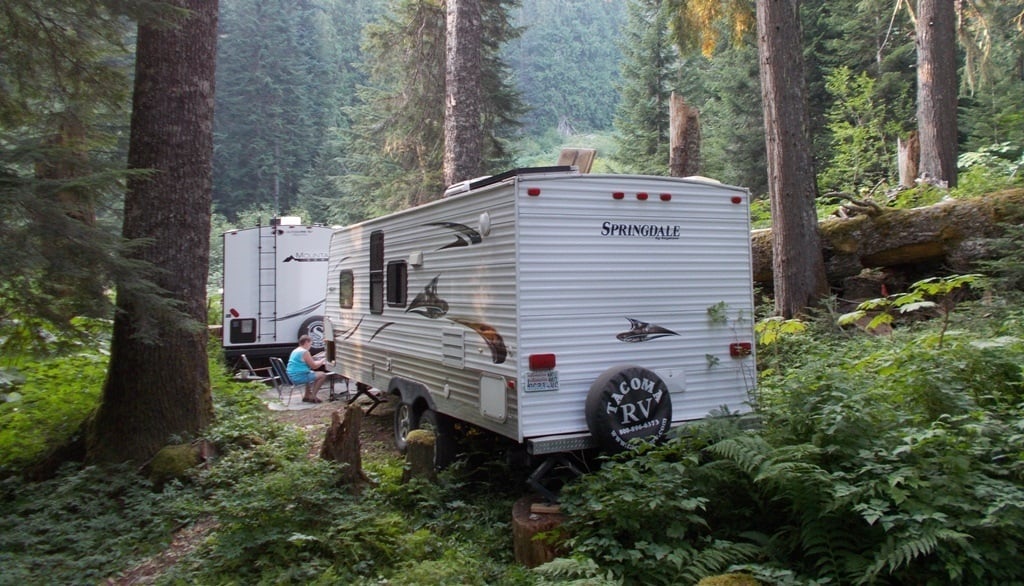When John Denver wrote the song Rocky Mountain High in Colorado forty-five years ago, he wasn’t predicting the legalization of cannabis. No, he was sharing the euphoria of being elevated in the mountains and the beauty they offer.
Many across the country have been suffering through an extended heat wave. Red Flag warnings, air quality alerts, and excessive heat warnings have dominated the national maps on most weather websites.
How does an RVer escape the heat when all the popular campgrounds and RV parks with hookups to run the AC are booked up for the summer? Well for those states with significant mountain ranges, especially in the west, take a cue from John Denver and find your own mountain high!

The trail at the bottom left leads to a cascading mountain stream.
You may recall from a long-ago school lesson that for every thousand feet of elevation gained the temperature will be approximately 3.5° F cooler. Example: Your home is located at an elevation of 1,000 ft with a predicted high temperature of 90°, you load up your RV and drive up to a stream in the mountains at 5,000 ft (4,000 ft higher than your home), upon arriving you should expect to enjoy a high temperature of 76° ( 3.5° X 4 – increments of 1,000 ft = 14° cooler).
If there are no available campgrounds in the mountains near you, consider finding a boondocking spot to enjoy within the boundaries of a national forest. Typically forest service roads that run along mountain streams offer numerous boondocking opportunities.

A beautiful alpine lake near camp.
If you can’t get high enough in the mountains to find a daytime temperature that is cool enough for your liking, hike to a still higher mountain peak or alpine lake to enjoy lower temperatures and the scenery, and return to your RV in the evening after the temperatures drop.
And oh, don’t forget to take some friends with you, as John Denver sang about, “friends around the campfire and everybody’s high.”
Enjoying the coolness of a mountain high—just another great adventure in RVing!

Thank you so much for including Camp Addict as a resource. We love boondocking and certainly agree that getting “high” up in some mountains is a great way to beat the summer heat. 🙂
Your boondocking and MVUM tutorial is very concise and saved we from trying to put it onto words of my own. Thanks!! Boondocking is the only way to go!
Hi- this is Kelly of Camp Addict- I asked Marshall to make that video because using the MVUM maps even confused me!! Ugh. So, it was needed and glad we could help out your article! Thanks,
Kelly B.
Agreed, the biggest problem I have with MVU Maps is figuring out which one I need and then orienting on the MVU Maps as they don’t show main highways very well as they don’t belong to the forest service.
LUV the Mountains.
[img]https://i.imgur.com/Uydb8qS.jpg[/img]
From dates on comments it appears Dave must have written this article about 2 years ago. If I’m correct that was about the time I was visiting my daughter and son in law and grandkids in Denver from Tucson, my home, which is around 2500 feet depending on which part of the area. The plan was a camping trip in the mountains near Estes Park. It was beautiful, cool, scenic at 8800 feet but the problem was on the second day I started having symptoms that got worse and worse and was convinced I was having a heart attack. My daughter drove me into town to a doctor. As we came down in elevation i started feeling better. The doctor ran several tests on me and said i had altitude sickness but my heart was fine. The reason the others in the party, I suppose, didn’t have a problem is they all live at 5200 feet (Denver) but I only live at 2500. If you’re a lowlander like me educate yourself on altitude sickness, which I have done since.